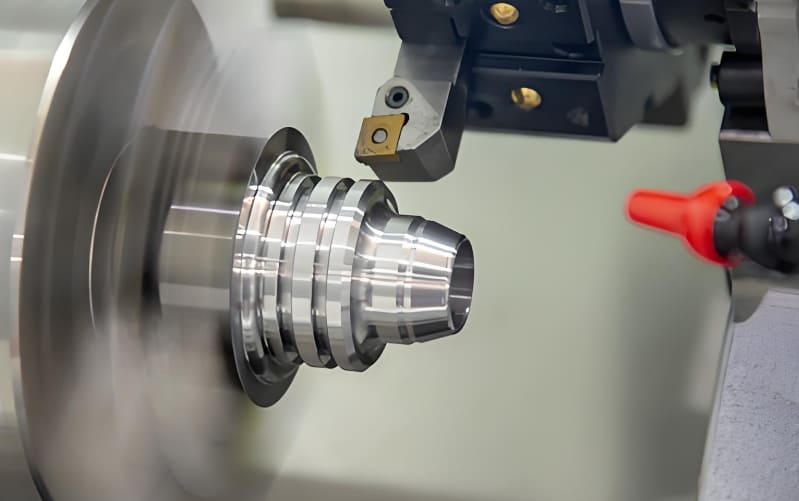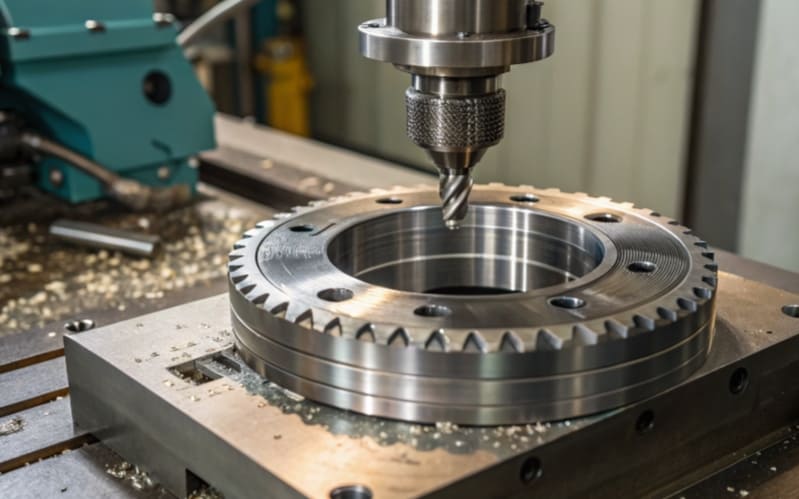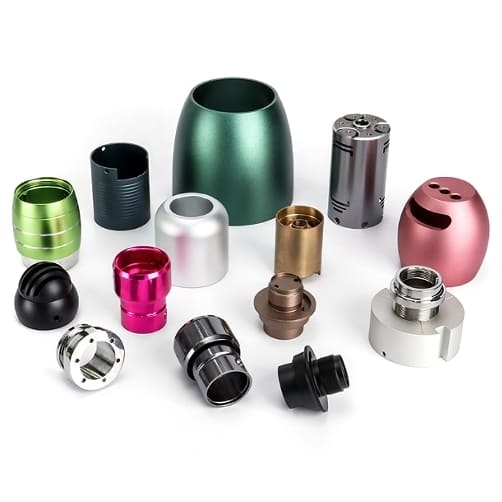Groove machining is a crucial part of many manufacturing processes, especially in industries requiring precise mechanical parts. In this article, we will explore what groove machining is, its different types, and the tools used. By understanding groove cutting techniques, you’ll be able to gain better insight into this fundamental machining process.
Groove machining refers to the process of cutting a groove or channel into a workpiece. It’s widely used in CNC machining, turning, and milling processes to create specific shapes and features.
But what exactly are the types of grooving, and how is this done? Let’s dive deeper into the various aspects of groove machining and discover its applications and methods.
What are the different types of grooving?
Imagine you’re tasked with machining a component that requires perfect fitting and functional grooves. But with so many types of grooving techniques available, how do you know which one is right for your needs? Understanding the various types of grooves can dramatically affect your part’s quality, functionality, and performance. Let’s break down the most commonly used types of grooving and their unique benefits.
The main types of grooving include external, internal, end, and face grooving. Each type serves a specific function depending on the shape and location of the groove required.
Grooves are essential for parts that need to fit together or require specific mechanical properties, such as sealing or fastening. Here’s a breakdown of some common types of grooving:
External Grooving
External grooving is performed on the outer surface of a part, often used in turning processes. This type of grooving is essential when the groove must be placed along the circumference or outer edge of a component. External grooves are commonly used for creating O-ring grooves, snap ring grooves, or other similar applications that require external fitment.

Applications of external grooving:
- O-ring grooves in automotive parts
- Snap ring grooves in machinery for secure fastening
- Aesthetic grooves on decorative parts
- Structural grooves for better assembly or joining parts
Internal Grooving
Internal grooving is used when a groove is needed inside a workpiece, such as in pipes, tubes, or other hollow components. It’s often done with specialized tools that can reach the internal diameter of the part. Internal grooves are crucial for sealing, flow regulation, or ensuring a tight fit for components inside a hollow part.

Applications of internal grooving:
- Fluid sealing in piping systems
- Tube connections requiring secure, leak-proof fits
- Structural elements inside cylindrical parts, such as shafts or bushings
- Creating space for components like bearings or internal locking mechanisms
End Grooving
End grooving creates grooves at the ends of the part, useful for fastening or assembly purposes. This type of grooving is ideal for parts that need to be joined together, such as creating grooves for bolts, screws, or other fasteners. The grooves can help align parts more accurately during the assembly process.

Applications of end grooving:
- Bolt or screw thread grooves
- Creating grooves for shaft couplings
- End caps or connectors in tubes and pipes
- Parts requiring a seamless assembly with pre-grooved ends
Face Grooving
Face grooving involves cutting grooves into the face of the workpiece, typically for parts like flanges, seals, or components that need to mate together with a precise surface fit. Face grooving is often done using milling or turning techniques, where the tool cuts directly into the surface of the material.

Applications of face grooving:
- Flange seal grooves for tight, secure sealing
- Precision grooves for mating parts in machinery
- Aesthetic grooves on visible surfaces
- Grooves designed to hold washers or other mechanical components
What is the purpose of groove cutting?
Have you ever wondered why a groove is needed in a part? Is it just for aesthetic reasons, or does it serve a more functional purpose? Groove cutting plays a pivotal role in ensuring parts fit together precisely and perform efficiently. Whether it’s for seals, locking mechanisms, or assembly, each groove serves a vital role in the final product. Let’s dive into the core reasons behind groove cutting and why it’s so critical in various industries.
Groove cutting is essential for creating tight fits, improving the aesthetics of parts, and enhancing their overall performance, such as providing space for O-rings or creating locking mechanisms.
Groove cutting plays a crucial role in ensuring parts fit together correctly, especially in industries like automotive, aerospace, and electronics.
Why is Groove Cutting Important?
Grooving can be used for:
- Seals and O-rings: Creating grooves for seals to prevent leakage and ensure airtight or watertight connections. This is essential in hydraulic, pneumatic, and fluid systems where pressure needs to be maintained.
- Locking features: Producing grooves that act as locking mechanisms. For example, locking grooves are used to secure components in place, preventing them from moving or coming loose under stress.
- Design elements: Grooves can be created for aesthetic or functional designs, such as creating step-like features for structural reinforcement or creating precise engagement features for components to fit securely.
What is the grooving machining process?
The process of groove machining might seem straightforward, but there are many factors that determine the success of the operation. From selecting the right tools to understanding the machine’s capabilities, every step is crucial for achieving the perfect groove. Have you ever wondered how manufacturers ensure precision and consistency with every groove they cut? Let’s break down the steps involved in this critical machining process.
The grooving machining process involves setting up the material in a CNC machine, using the appropriate tool to cut the groove, and ensuring precision throughout the operation.
This process begins by selecting the right machine for the job, such as a CNC lathe or mill. The tool is then positioned, and the machine makes precise cuts to form the groove according to the design specifications.
Steps in the Grooving Process:
- Machine Setup: Choosing the machine and securing the workpiece. The setup includes ensuring the material is fixed and properly aligned, as any misalignment can result in inaccuracies in the groove.
- Tool Selection: Picking the correct grooving tool, which can vary based on groove type and material. The tool should be selected based on factors like groove depth, material hardness, and required precision.
- Cutting Operation: The tool is moved into the material to cut the groove. This operation involves precise control over the tool path, speed, and cutting depth to achieve the desired groove dimensions.
- Finishing: After the groove is cut, finishing may be required to smooth the edges and achieve the desired surface finish. This could include additional polishing or deburring to remove any sharp edges or burrs.
Which lathe tool is used to cut grooves?
Choosing the right tool for cutting grooves can feel overwhelming with all the available options. But knowing which lathe tool works best for your project is key to achieving the desired groove quality. Have you ever faced challenges in selecting the right tool to achieve precision in your grooving operations? Let’s explore the tools most commonly used for cutting grooves and how to select the perfect one for your needs.
Grooving tools such as carbide inserts, grooving cutters, and toolholders are commonly used to perform precise cuts, ensuring tight tolerances and high-quality results.

The tool selection depends largely on the material of the workpiece, the depth of the groove, and the groove shape. Carbide inserts are frequently chosen for their durability and ability to maintain sharp edges for precise cuts.
Common Lathe Grooving Tools:
- Carbide Insert Tools: Provide sharp edges and high wear resistance. They are ideal for cutting hard materials and maintaining high cutting speeds without compromising precision.
- Grooving Cutters: Used for producing wide grooves, grooving cutters can be tailored to create specific groove profiles and are often used in CNC machines for precision work.
- Toolholders: Secure the grooving tools in place during the operation. A stable and secure toolholder is crucial to ensure that the tool remains aligned with the workpiece throughout the cutting process.
What are some methods of cutting a groove?
When it comes to cutting grooves, different methods offer distinct advantages based on the material, depth, and precision required. Do you know which method is best suited for your specific project? Whether you’re working with metals or plastics, understanding the best method for groove cutting can help you achieve better results and minimize errors. Let’s take a look at the various methods and their ideal applications.
Groove cutting methods include turning, milling, laser cutting, and EDM, each with distinct advantages based on material and groove specifications.
The most common methods for groove cutting include:
- Turning: Involves rotating the workpiece while a fixed tool cuts the groove. This method is ideal for cylindrical parts and offers high precision in the creation of external grooves.
- Milling: Uses a rotating cutter to cut grooves into stationary material. Milling is often used for larger, more complex grooves that require intricate geometry or specific features.
- Laser Cutting: For high-precision cuts, especially on thin materials. Laser cutting is suitable for fine, narrow grooves with tight tolerances and minimal material wastage.
- EDM (Electrical Discharge Machining): Ideal for cutting intricate and deep grooves. EDM is used for cutting hard materials and can create very fine details that are difficult to achieve with traditional cutting methods.
What is the depth of a groove cutting?
The depth of a groove plays a critical role in the function and integrity of the part. Have you ever wondered how deep your groove should be for optimal performance? Achieving the right groove depth ensures the part fits and functions as designed. Let’s explore how depth is determined and why it’s a critical factor in groove machining.
The depth of a groove depends on the application and design specifications. Typically, groove depths can range from a few millimeters to several centimeters.

Groove depth is critical for creating proper fits, especially in parts that require precise sealing or locking. Ensuring the right depth helps prevent excessive wear or material failure.
Factors Affecting Groove Depth:
- Material Type: Harder materials may require more careful depth control. For example, harder metals can make it difficult to achieve deep grooves without special tools or adjustments.
- Part Function: Sealing grooves need to be precise and consistent. Groove depth must match the design specifications to ensure the seal’s effectiveness.
- Tool Capability: The grooving tool’s depth range must be considered. Some tools can only handle shallow grooves, while others are designed for deeper cuts.
How do you calculate groove depth?
Calculating groove depth can be a tricky process, as it involves understanding both the design and material requirements. Have you ever found yourself questioning the best way to calculate groove depth for a project? The depth must align with your design specifications, part function, and material type. Let’s dive into the steps and guidelines for determining the right groove depth.
Groove depth can be calculated by referencing design blueprints or CAD models, taking into account material properties and the desired fit.
The groove depth is usually calculated from the centerline of the workpiece or relative to the surface. Engineers use precise measurements to ensure the groove fits the intended application.
Steps in Calculating Groove Depth:
- Review CAD Drawings: Check the design specifications for depth. CAD models provide exact values and ensure the groove depth is accurate.
- Material Consideration: Adjust calculations for material thickness and strength. Softer materials may require more depth to achieve the necessary fit.
- Tool Limits: Ensure the cutting tool can achieve the desired depth. Some tools may have limitations based on their size or the material being cut.
What is the primary purpose of grooving metal edges?
Grooving metal edges serves several important functions in the manufacturing process, but why exactly is this step so critical? Whether it’s for improving part strength, aiding in assembly, or ensuring precise sealing, the purpose of grooving goes far beyond aesthetics. Let’s explore how grooving metal edges plays a crucial role in various applications.
Grooving metal edges creates specific features for assembly, sealing, or improving part strength. This process is critical in industries like automotive and aerospace.
In the metalworking industry, grooving is essential to achieving precision fits and ensuring the durability of components. Whether it’s for assembly or sealing, the grooves make parts more functional.
What is the difference between cut groove and roll groove?
Understanding the difference between cut grooves and roll grooves can be the key to selecting the right technique for your project. But what sets these two methods apart? Each has its own advantages, depending on the part’s design and the material being worked with. Let’s examine the differences and see why choosing the right method is essential for optimal results.
Cut grooves are created by using cutting tools, while roll grooves are formed by applying pressure to shape the material, typically used for pipe fittings or seals.

Cut grooves are sharper and offer more precise control, while roll grooves are typically used in applications requiring less precise depth but higher material deformation.
Cut Groove vs Roll Groove:
- Cut Grooves: More precise, created with cutting tools. Ideal for applications requiring tight tolerances and sharp edges.
- Roll Grooves: Less precise, formed using a rolling process to create a deeper groove. Often used in piping systems where the groove does not require extreme precision but needs to withstand pressure.
What is groove milling?
Groove milling is often used for parts that require intricate or large grooves. It’s a versatile process, but what makes it stand out from other grooving methods? If you’re looking for high precision with larger grooves, milling might just be the best option. Let’s explore groove milling and why it’s used for complex projects.
Groove milling is used for more intricate and larger grooves, employing a rotating cutter to remove material and create precise channels in a workpiece.
Milling allows for precise control over the depth and shape of the groove. It’s especially useful in situations where high precision and complex geometries are required.
What is the RPM used to cut a groove?
Choosing the right RPM (revolutions per minute) is essential for achieving smooth, efficient groove cuts. But how do you determine the ideal RPM for your specific project? Too high or too low can result in poor cut quality or tool wear. Let’s explore how to find the optimal RPM for groove cutting.
The RPM for cutting a groove is determined by factors like material hardness and tool type, with typical RPM values ranging from 500 to 3,000 depending on the setup.
Each material has an optimal cutting speed to ensure the groove is cut efficiently and accurately without damaging the tool or workpiece.
What is the G code for grooving?
For CNC machines to cut grooves precisely, they need specific instructions. Do you know what G code is used for grooving operations? The right G code makes all the difference in ensuring that your groove cuts are accurate and meet the design specifications. Let’s explore the important G codes used for grooving.
The G code for grooving is typically G75 for external grooving and G76 for internal grooving, depending on the machine and tool setup.
G codes are essential in CNC machining, guiding the machine through the necessary motions to perform tasks like grooving. The correct G code ensures the groove is cut accurately according to the design.
Conclusion
Groove machining is an essential process in modern manufacturing. By understanding the different types, methods, and tools used, you can make informed decisions for your specific machining needs.
